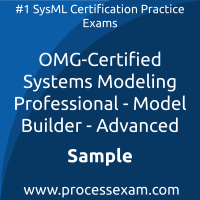 You have to pass the OMG-OCSMP-MBA400 exam to receive the certification from OMG. To increase the effectiveness of your study and make you familiar with the actual exam pattern, we have prepared this OMG OCSMP Advanced sample questions. Our Sample OMG-Certified Systems Modeling Professional - Advanced Practice Exam will give you more insight about both the type and the difficulty level of the questions on the OMG SysML MBA exam.
You have to pass the OMG-OCSMP-MBA400 exam to receive the certification from OMG. To increase the effectiveness of your study and make you familiar with the actual exam pattern, we have prepared this OMG OCSMP Advanced sample questions. Our Sample OMG-Certified Systems Modeling Professional - Advanced Practice Exam will give you more insight about both the type and the difficulty level of the questions on the OMG SysML MBA exam.
However, we are strongly recommending practice with our Premium OMG-Certified Systems Modeling Professional - Model Builder - Advanced Practice Exam to achieve the best score in your actual OMG-OCSMP-MBA400 Exam. The premium practice exam questions are more comprehensive, exam oriented, scenario-based and exact match of OMG-Certified Systems Modeling Professional - Advanced exam questions.
OMG OCSMP Advanced Sample Questions:
01. What is the purpose of using OCL (Object Constraint Language) in SysML to assess model quality?
a) To define the behavior of blocks in a state machine
b) To formally specify constraints and conditions on model elements
c) To allocate communication resources between elements
d) To sequence actions in activity diagrams
02. How does SysML integrate with UML to support the transition from systems to software design?
a) By using parametric diagrams
b) By utilizing activity diagrams to model real-time operations
c) By allocating resources based on system requirements
d) Through the use of UML class diagrams and SysML block diagrams for systems and software representation
03. In what way does the integration of SysML with UML benefit the system engineering process?
a) It helps manage system state transitions.
b) It ensures compatibility with enterprise frameworks like DoDAF.
c) It facilitates the transition from systems engineering to software engineering by bridging the two modeling languages.
d) It enables real-time analysis and performance optimization.
04. What is a key consideration when selecting a tool for integrating SysML with other tools?
a) The tool's ability to sequence real-time operations
b) The tool's support for XMI, RIF, or AP233 model interchange standards
c) The tool's capacity to model hardware components
d) The tool’s compatibility with activity diagramming
05. Which model interchange standard facilitates communication between SysML tools and aerospace system models?
a) XMI
b) UML
c) Modelica
06. When specifying a viewpoint in SysML, what is the primary factor to consider?
a) The system’s behavior over time
b) The allocation of resources within the system
c) The sequence of actions in the activity diagram
d) The stakeholder’s concerns and how they relate to the model
07. When using OCL to specify constraints in SysML, which of the following is a key feature of the language?
a) It provides formal validation of constraints on model elements.
b) It defines behavioral transitions in state machines.
c) It sequences actions in activity diagrams.
d) It assigns resources to system components.
08. In SysML, what is the purpose of assessing model quality throughout the system development process?
a) To generate more iterations
b) To ensure that the system design meets stakeholder requirements and functions as intended
c) To define resource allocation
d) To reduce the complexity of state machines
09. Which of the following is a core feature of MARTE that enhances SysML for real-time environments?
a) Activity sequencing
b) Use case modeling for real-time systems
c) Resource allocation modeling and real-time scheduling
d) Block definition for hardware elements
10. How can metamodel-based extensions be applied to support specialized domains in SysML?
a) By modifying the SysML language at a metamodel level to introduce new concepts
b) By adding stereotypes to existing blocks
c) By simplifying state transitions within a system
d) By defining parametric relationships between system components
Answers:
Question: 01
Answer: b |
Question: 02
Answer: d |
Question: 03
Answer: c |
Question: 04
Answer: b |
Question: 05
Answer: d |
Question: 06
Answer: d |
Question: 07
Answer: a |
Question: 08
Answer: b |
Question: 09
Answer: c |
Question: 10
Answer: a |
If you find any errors or typos in OMG-Certified Systems Modeling Professional - Model Builder - Advanced (OMG-OCSMP-MBA400) sample question-answers or online OMG SysML MBA practice exam, please report them to us on feedback@processexam.com
 You have to pass the OMG-OCSMP-MBA400 exam to receive the certification from OMG. To increase the effectiveness of your study and make you familiar with the actual exam pattern, we have prepared this OMG OCSMP Advanced sample questions. Our Sample OMG-Certified Systems Modeling Professional - Advanced Practice Exam will give you more insight about both the type and the difficulty level of the questions on the OMG SysML MBA exam.
You have to pass the OMG-OCSMP-MBA400 exam to receive the certification from OMG. To increase the effectiveness of your study and make you familiar with the actual exam pattern, we have prepared this OMG OCSMP Advanced sample questions. Our Sample OMG-Certified Systems Modeling Professional - Advanced Practice Exam will give you more insight about both the type and the difficulty level of the questions on the OMG SysML MBA exam.